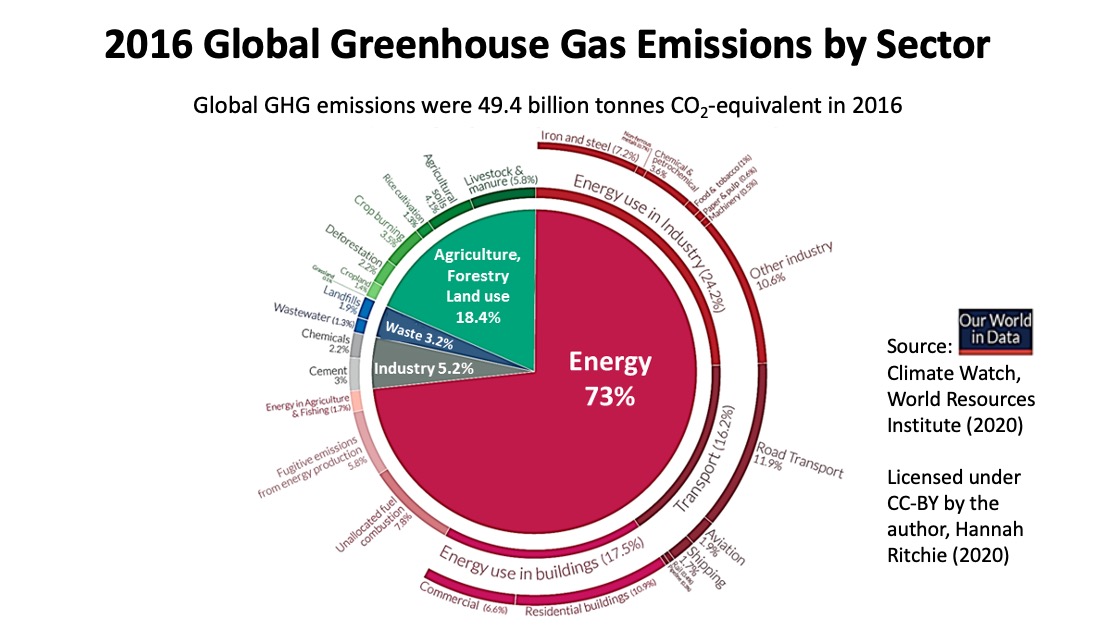School Gardens and
Climate Change
What do school gardens have to do with climate change? Believe me, school gardens are rapidly becoming the most important place of learning in your school!
In fact, I believe the most important curriculum for today's students is learning how to grow food (and collect rainwater, build soil, generate energy, and become resilient) in a changing climate.

Through one simple little act, we can cultivate a world that is more diverse, unified and collaborative, and less divided and lonely — ultimately, a world more joyous and sustainable than this one through one simple act: gardening.
— Jasun "Plaedo" Wellman
As the climate crisis worsens — threatening our food and water security — our students need to be learning how to grow food in ways that both fight climate change and regenerate the earth ... and the Earth.
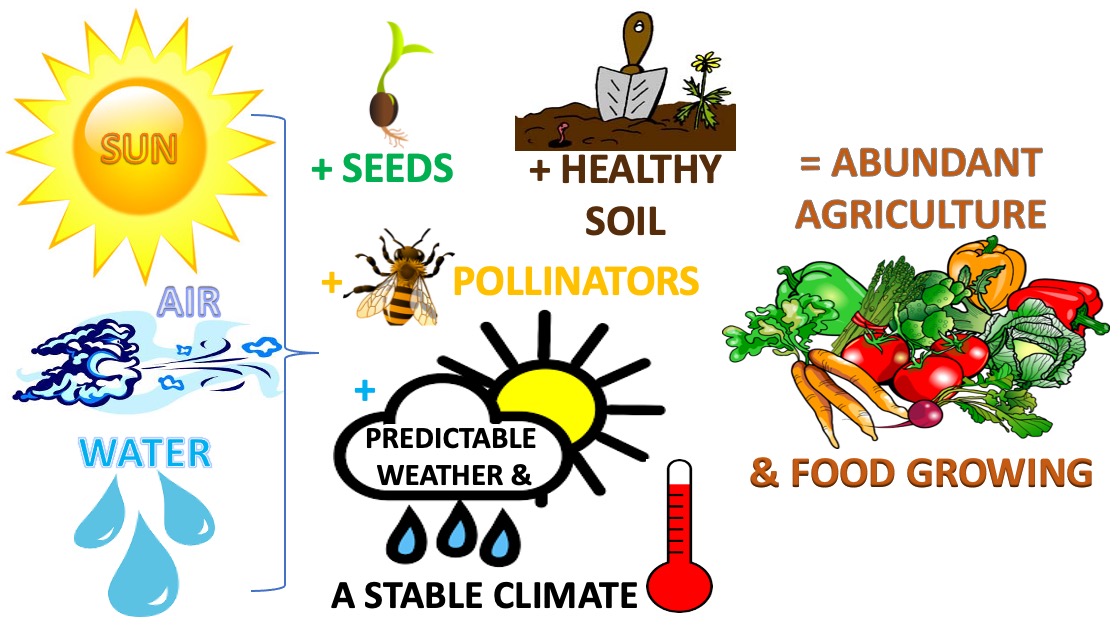
Younger students learn that it's sunshine, soil and water (with the help of pollinators) that help seeds to grow. When planting densely (to grow more in the same amount of space), air circulation is also important.
Older students learn the significance of a stable climate and predictable weather for growing food year in, year out. Indeed, agriculture was "invented" in most places around the world approximately 10,000 years ago, when the end of the last ice age provided a fairly stable climate at the global level. (Different regions have experienced ups and downs in that stability over the centuries.)
Over the last 10,000 years, humans have developed into a species almost entirely dependent on agriculture (people in the Arctic are a notable exception, but even that is changing), but now the climate is becoming less and less stable and dependable for our food growing and our food security.
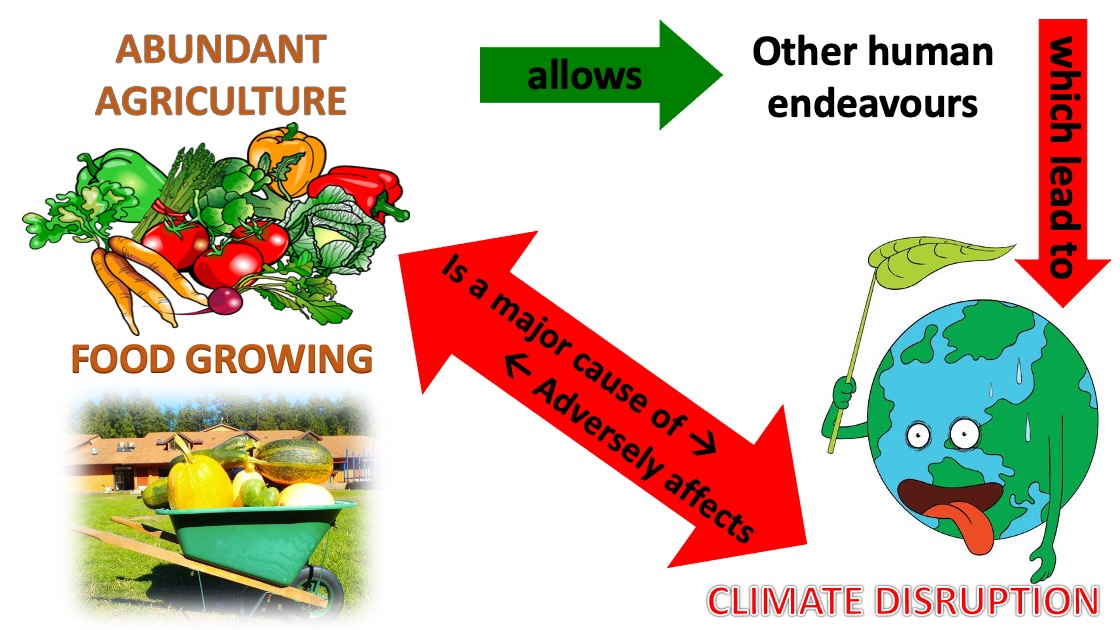
It's agriculture (versus hunting and gathering) that has allowed human beings to flourish in almost every ecosystem. And now, especially since the Industrial Revolution, human activities are emitting so many greenhouse gases (GHGs) that we're warming the atmosphere, which is disrupting the stable climate we rely on.
Not only that, but agriculture itself is a major cause of climate change (for example, the tilling of soil releases carbon, and nitrogen fertilizers release nitrous oxide — a potent GHG), while climate change adversely affects our food growing due to increasing heatwaves, floods, droughts, wildfires and extreme weather events (such as hailstorms).
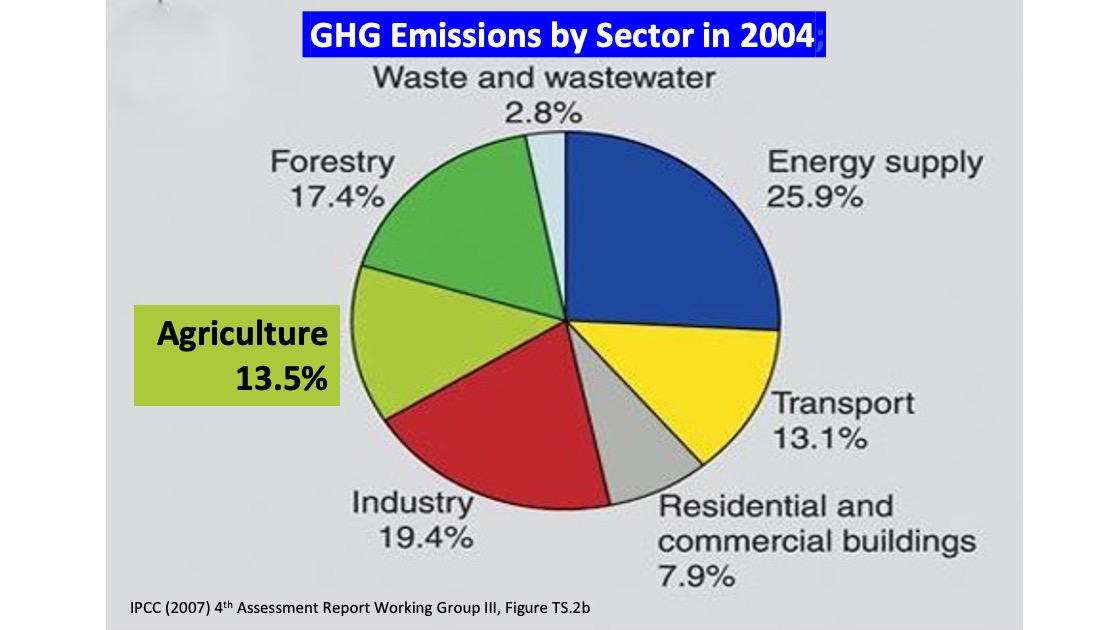
According to the IPCC (Intergovernmental Panel on Climate Change), 2004 greenhouse gas emissions from the agriculture sector were 13.5% of the total.
By 2016, agricultural emissions had risen to 16.1%. These include emissions from agricultural soils, especially from tillage and use of nitrogen-based synthetic fertilizers (4.1%); rice cultivation, which releases a lot of methane (1.3%), crop burning (3.5%); degraded croplands (1.4%); and livestock and manure (5.8%), not including the impacts of land use change to create pasture or to grow animal feed.
According to Hannah Ritchie (2020) with Climate Watch and the World Resources Institute, "The food system as a whole — including refrigeration, food processing, packaging, and transport — accounts for around one-quarter of greenhouse gas emissions." [Then there's the energy used in agricultural machinery and fishing vessels, which amounts to another 1.7% of global emissions.]
Agriculture is causing a large proportion of our greenhouse gas emissions.
And crops all over the world are increasingly threatened, so we can't leave it up to our beleaguered farmers, who are facing increased heatwaves, droughts or flooding (and sometimes both), pests and crop diseases, and more.
That's the What.
So, what's the So What? It's that food can't be grown overnight (although sprouts come close). Nor can we learn to grow food overnight — especially in a changing climate.
SO WE MUST TEACH OUR STUDENTS HOW TO GROW THEIR OWN FOOD IN THE SCHOOL GARDEN ... NOW!
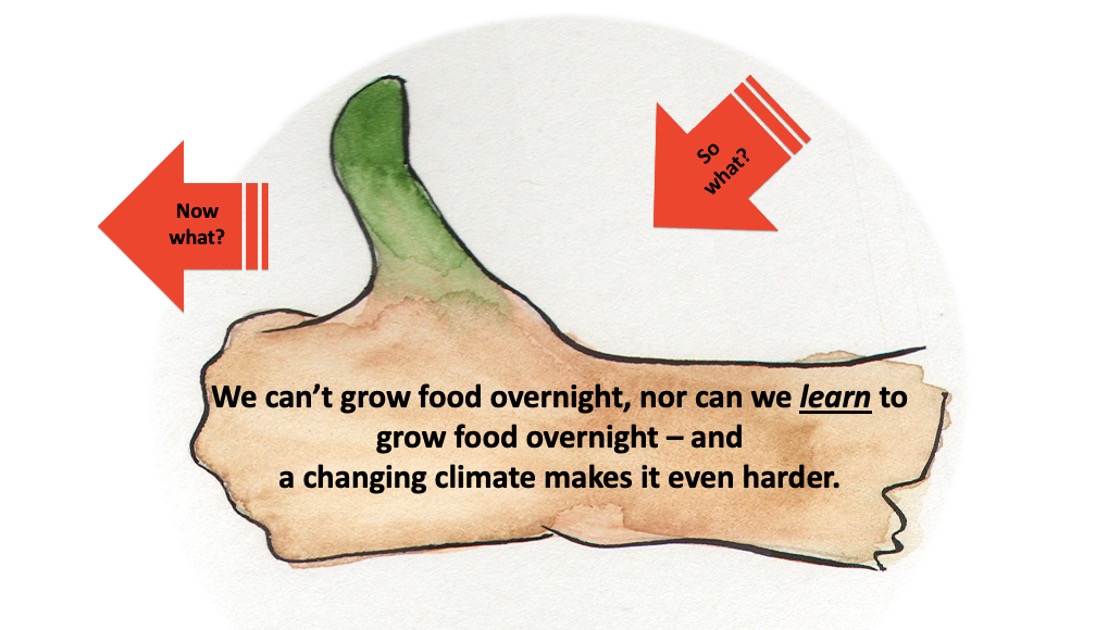
The Now What? is that we must all be teaching our students (and learning right along with them, if necessary) the skills and habits of head, heart and hands needed to successfully grow enough food to be food secure for as long as possible.
We must help our students:
- (HEAD) understand the science of growing plant foods (especially how to experiment with adaptations to different weather conditions and climate disruption)
- (HEART) develop the foresight, dedication, and compassion needed to become local food growers — and sharers, and
- (HANDS) practise the hands-on skills of food growing
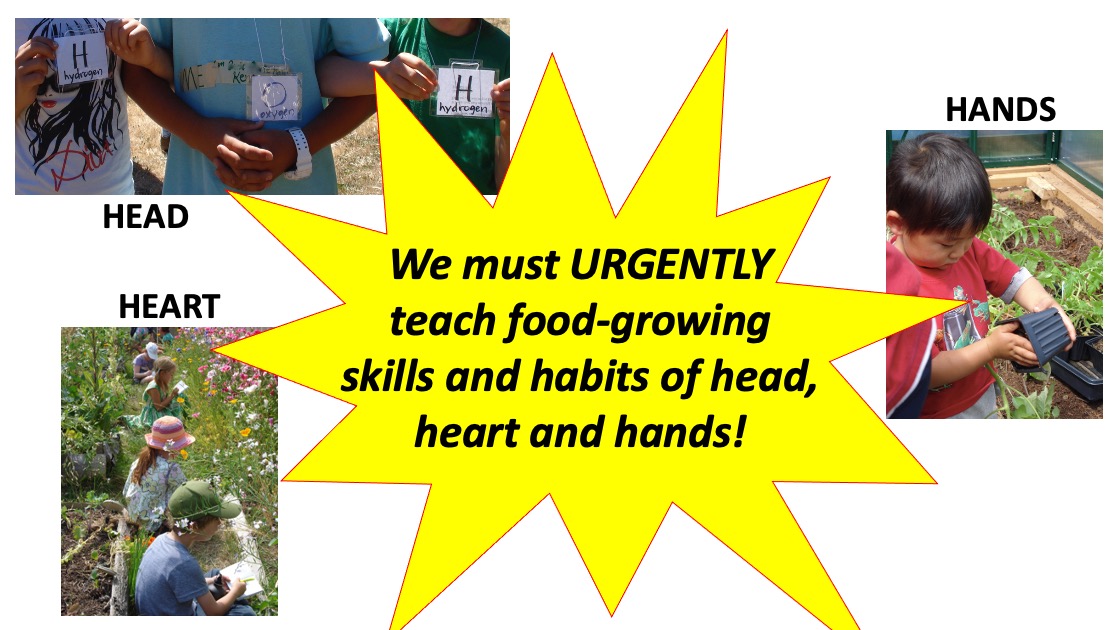
Simple Strategies for Cultivating Resilience in Our School Gardens
Teachers and their students can grow food, help mitigate climate change, and build resilience in the school garden by:
PROTECTING THE SOIL
• Respect the soil food web
• Mulch, mulch, mulch!
• Don’t turn your soil over (which smothers your aerobic micro-organisms and fries your anaerobic ones in the sun)
• Use no-till methods to keep carbon in the soil
• Use only natural amendments; develop soil fertility by adding organic matter rather than by fertilizing
• Make and spread compost
• Plant leguminous cover crops over winter
• Respect beneficial weeds (e.g., those that whose roots prevent erosion)
BEFRIENDING THE SUN
• Plant trees strategically to create dappled shade during mid-afternoon heat
• Use mulch to keep the soil cool
• Use hoop houses and shade cloth
• Create a shade structure for students
CONSERVING YOUR WATER
• Water in early morning to prevent evaporation (and disease)
• Water deeply and therefore less frequently
• Plant intensively to create a “canopy” of leaves as a "living mulch"
• Install an irrigation system, if necessary
• Build ditches or swales (ditches on contour) to slow, spread and sink rainfall
• Build hugelkultur beds to maintain moisture
• Try wicking beds
• Capture and store rainwater
• Carefully choose fruits and veggies to grow based on water availability, especially in the summer
SAFEGUARDING BIODIVERSITY
• Grow heritage varieties and save their seeds
• Save landrace seeds — those that have adapted to your climate and environment
• Include pollinator-friendly plants that flower at different times throughout the season
• Plant companion plants that attract beneficial insects
• Build an insect hotel
• Allow some hedgerows or “messy” spots in your garden for small animals to reside in
• Don't use pesticides
BEING CARBON-SMART
• Reduce fossil fuel CO2 emissions (e.g., the manufacture of synthetic pesticides and fertilizers is carbon-intensive)
• Avoid nitrogen-based fertilizers especially (nitrous oxide is a highly potent greenhouse gas)
• To avoid carbon loss, don’t leave soil naked (again, mulch, mulch, mulch!)
• Learn about “food miles”
• Incorporate fruit trees and berry bushes into schoolyard landscaping
• Use people power ("Many hands make light work")
• Use hand / solar-powered tools
• Use local resources that aren’t shipped long distances (for example, ask the neighbourhood for donations of fallen leaves every autumn)
• Avoid using peat products
• Have students reduce, re-use, recycle and repair
• Encourage plant-based eating
Adapted with thanks from The Climate-Friendly Gardener: A Guide to Combating Global Warming from the Ground Up (Union of Concerned Scientists).

Be prepared for hot/dry weather, cool/wet weather, extreme cold, extreme heat, rain, wind or whatever is coming next....
— Linda Gilkeson, Resilient Gardens for a Changing Climate
Impacts of Climate Change on Food Security and Agriculture
Intergovernmental Panel on Climate Change (2014) 5th Assessment Report, Working Group II, Chapter 7, Executive Summary
The effects of climate change on crops and food production are evident in several regions of the world […]. Negative impacts of climate trends have been more common than positive ones [Figures 7-2, 7-7]. Since AR4 [2007], there have been several periods of rapid food and cereal price increases following climate extremes in key producing regions, indicating a sensitivity of current markets to climate extremes among other factors [Figure 7-3, Table 18-4]. Several of these climate extremes were made more likely as the result of anthropogenic emissions […] [Table 18-4].
Studies have documented a large negative sensitivity of crop yields to extreme daytime temperatures around 30ºC [Chapter 5 AR4, 7.3.2.1.1]. These sensitivities have been identified for several crops and regions and exist throughout the growing season [...]. Under scenarios of high levels of warming, leading to local mean temperature increases of 3-4ºC or higher, models based on current agricultural systems suggest large negative impacts on agricultural productivity and substantial risks to global food production and security […] [7.4.1, Figures 7-4, 7-7].
Changes in climate and CO2 concentration will enhance the distribution and increase the competiveness of agronomically important and invasive weeds […] [7.3.2.3].
All aspects of food security are potentially affected by climate change, including food access, utilization, and price stability […] [7.3.3.1, Table 7-1]. Climate change will increase progressively the inter-annual variability of crop yields in many regions […] [Figure 7-6].
Nutritional quality of food and fodder, including protein and micronutrients, is negatively affected by elevated CO2 […] [7.3.2.5].
Without adaptation, local temperature increases in excess of about 1ºC above pre-industrial are projected to have negative effects on yields for the major crops (wheat, rice and maize) in both tropical and temperate regions […] [7.4, Figures 7-4,7-5,7-7].
Changes in temperature and precipitation, without considering effects of CO2, will contribute to increased global food prices by 2050, with estimated increases ranging from 3-84% […]. Projections that include the effects of CO2 changes, but ignore ozone and pest and disease impacts, indicate that global price increases are about as likely as not, with a range of projected impacts from -30% to +45% by 2050 [7.4.4].
A range of potential adaptation options exist across all food system activities, not just in food production, but benefits from potential innovations in food processing, packaging, transport, storage and trade are insufficiently researched [7.1, 7.5, 7.6, Figures 7-1, 7-7, 7-8]. More observational evidence is needed on the effectiveness of adaptations at all levels of the food system [7.6].
IPCC (2018) Global Warming of 1.5°C. An IPCC Special Report on the impacts of global warming of 1.5°C above pre-industrial levels and related global greenhouse gas emission pathways, in the context of strengthening the global response to the threat of climate change, sustainable development, and efforts to eradicate poverty, Chapter 3.
Global warming is expected to rise by 1.5ºC over pre-industrial levels “between 2030 and 2052 if it continues at the current rate” with heightened “risks to health, livelihoods, food security, water supply, human security, and economic growth.”
Climate change influences food and nutritional security through its effects on food availability, quality, access and distribution (Paterson and Lima, 2010; Thornton et al., 2014; FAO, 2016). The effects of climate change on crop yield, cultivation area, presence of pests, food price and supplies are projected to have major implications for sustainable development, poverty eradication, inequality and the ability of the international community to meet the United Nations sustainable development goals (SDGs; Cross-Chapter Box 4 in Chapter 1).
For C3 crops [rice, wheat, barley, rye, oats, soybean, peanut, cotton, sugar beets, potato; about 85% of plants, including trees], theoretically advantageous CO2 fertilization effects may not be realized in the field; further, they are often accompanied by losses in protein and nutrient content of crops (Section 3.6), and hence these projected benefits may not be realized. In addition, some micronutrients such as iron and zinc will accumulate less and be less available in food (Myers et al., 2014).
IPCC (2018) Global Warming of 1.5°C, Summary for Policy Makers
B.5. Climate-related risks to health, livelihoods, food security, water supply, human security, and economic growth are projected to increase with global warming of 1.5°C and increase further with 2°C. (Figure SPM.2)
B.5.1. Populations at disproportionately higher risk of adverse consequences with global warming of 1.5°C and beyond include disadvantaged and vulnerable populations, some indigenous peoples, and local communities dependent on agricultural or coastal livelihoods (high confidence).
B.5.6. For global warming from 1.5°C to 2°C, risks across energy, food, and water sectors could overlap spatially and temporally, creating new and exacerbating current hazards, exposures, and vulnerabilities that could affect increasing numbers of people and regions (medium confidence).
C.2.5. [...] Such large transitions pose profound challenges for sustainable management of the various demands on land for human settlements, food, livestock feed, fibre, bioenergy, carbon storage, biodiversity and other ecosystem services (high confidence). Mitigation options limiting the demand for land include sustainable intensification of land-use practices, ecosystem restoration, and changes towards less resource-intensive diets (high confidence).
D.3.4. [...] Trade-offs between mitigation and adaptation, when limiting global warming to 1.5°C, such as when bioenergy crops, reforestation or afforestation encroach on land needed for agricultural adaptation, can undermine food security, livelihoods, ecosystem functions and services and other aspects of sustainable development (high confidence).
D.4.3. 1.5°C and 2°C modelled pathways often rely on the deployment of large-scale land-related measures like afforestation and bioenergy supply, which, if poorly managed, can compete with food production and hence raise food security concerns (high confidence).
Go to School Gardens
Visit our Climate Change Primer
Learn more Climate Change Strategies for School Gardens
